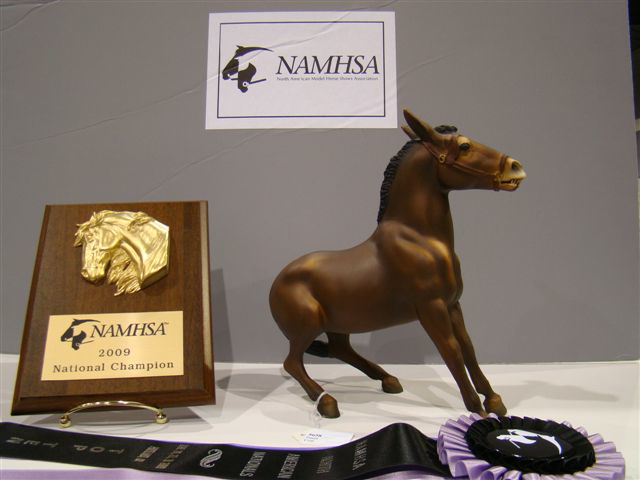
Collectibility is a relatively new division in live showing. Traditionally, a model’s rarity was considered in regular breed classes. But with Breyer’s introduction of newer, more detailed, and often more accurate molds, rare vintage models were gradually being squeezed out of traditional breed classes.
Enter collectibility, a division designed to reflect the actual activity of collection in a NAMHSA-friendly form. Just like a Breyer collector looking to expand their collection, a judge will consider factors such as rarity, age, desirability, and aesthetics:
Rarity: Simply, how many were made?
Age: Age matters both by itself and how much it impacts rarity and condition. Models “disappear” over the years. They end up in attics and landfills, sometimes never to be seen again. Thus, less are available to collectors seeking them out than the original produced amounts. Age implies various threats to a model’s condition. A model must survive transportation, pets, small children, and environmental factors to remain mint many years after production.
Desirability: Do people actually want to buy it? If 50 were made, but you can’t find 50 collectors who want to own one, is it really collectible? How popular is this model or mold? PAM, Silver, and the Semi-Rearing Mustang all have strong cult like followings. But Galiceno, Black Beauty, and the Racehorse? Not so much. This factor comes strongly into play when judging Conn collectibility.
Aesthetics: Are there rubs? Is the model yellowed? Are there factor flaws? On the flip side, the model’s color attractive? Is the paint job particularly well rendered? All are factors that come into play in the show ring. Remember those color classes I mentioned yesterday? This is what they are judged on.
From judge to judge, you will more variation in how these elements are weighed than the elements of your average breed class. I’ve run into just as many judges that consider condition over rarity, rarity over age and vice versa.
If you’re interested in reading more on the topic collectibility, I highly recommend checking out the Breyer History Diva. Her perspective is more on the collecting side than the showing side and full of tons of valuable insight.
Here’s the point my official post stops and move on to the editorial portion of our program:
Notice in the above few paragraphs how I kept referring to Breyers? While the same principles apply to manufactures such as Hartland and Hagen-Renaker, things go off the tracks when we start talking about Peter Stones.
When I’ve been asked about Stone collectibility before, I tend to answer with variation of my “spaghetti theory”: throw it against the wall and see what sticks. Don’t get me wrong, Peter Stones are certainly collectible (in the traditional sense--like the way shot glasses and modern art are collectible.) But how does a judge distinguish one from another? Stone produces more special runs than regular runs and more test runs and one-of-a-kinds than anything else. When everything is rare, is anything rare?
So much for rarity, but what about age? Stones have only been in production for 13 years, and most Stone models currently winning are less than five years old. Even desirability plays a lesser part as the Stone company is very good about sweeping unpopular molds under the rug (see Jumping Horse, Morgan, Western Pleasure Horse, Rearing Horse…)
That just leaves aesthetics. With the company’s spotty history with quality control, factory flaws are always an issue. They apply a wide variety of colors and techniques to their models with varied amounts of success. Most of these techniques are brought in or borrowed from custom finish artists so that some Stones closer resemble customs than factory painted models.
Personally, I would like to see an increase in color or OF workmanship classes for Stones. While I vehemently oppose "pretty pony" judging for Breyers, Hagen-Renakers, and Hartlands, the unique nature of Stone’s production practices render the traditional measuring sticks of collectibility useless. A judging system with a stronger or exclusive emphasis on aesthetics would more accurately approximate what collectors are seeking out already.
Tune in on Monday for the exciting conclusion of "Those Mysterious Yellow Cards" when I talk about my favorite division, workmanship!






2 comments:
For the Stones, I always half-joke that they should sort it out categorically by price. Although that should theoretically work with most finishes.
It's probably a more logical way to sort them out than what you see now.
Post a Comment